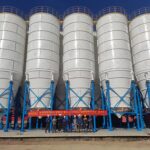Cleaning and Sanitation for a Bakery and Confectionery Factory
Bakery and Confectionery Factory
 A bakery and confectionery factory is a facility where large-scale production of bread, pastries, and sweets takes place.
A bakery and confectionery factory is a facility where large-scale production of bread, pastries, and sweets takes place.
It involves processes such as ingredient handling, dough preparation, proofing, baking, confectionery production, packaging, quality control, and distribution. These factories aim to efficiently produce a variety of baked goods while maintaining high standards of hygiene and quality throughout the manufacturing process.
The Maintenance Needs
1. Equipment Inspections: Regularly inspect and assess the condition of mixers, ovens, conveyors, and other machinery to identify any signs of wear, damage, or malfunction.
2. Cleaning and Sanitation: Implement a thorough cleaning schedule for all equipment and production areas to maintain hygiene standards and prevent cross-contamination.
3. Lubrication: Ensure that moving parts of machinery are adequately lubricated to reduce friction and prevent wear and tear.
4. Temperature and Humidity Control: Calibrate and monitor ovens and climate control systems to maintain optimal temperature and humidity levels for baking and storage.
5. Ingredient Handling: Implement proper storage and handling procedures for ingredients to prevent spoilage and contamination.
6. Quality Control: Regularly assess product quality to identify and address any issues in the production process promptly.
7. Electrical Systems: Inspect and maintain electrical components to prevent breakdowns and ensure the safety of the facility.
8. Staff Training: Train staff on proper equipment use, maintenance procedures, and adherence to safety and hygiene protocols.
9. Packaging Machinery: If applicable, maintain and calibrate packaging machinery to ensure accurate and efficient packaging of finished products.
10. Emergency Preparedness: Have contingency plans in place for unexpected events, such as power outages or equipment failures, to minimize downtime.
11. Record-keeping: Maintain records of maintenance activities, inspections, and repairs to track the performance of equipment over time.
Regular and proactive maintenance is crucial to ensuring the smooth and efficient operation of a bread and confectionery factory while upholding product quality and safety standards.
Cleaning and Sanitation
Cleaning and sanitation in a bakery and confectionery factory are critical for preventing contamination and maintaining high hygiene standards. Here’s an elaboration on the process:
1. Cleaning Schedule:
- Establish a comprehensive cleaning schedule outlining when each piece of equipment and production area should be cleaned
- Categorize tasks based on frequency, with daily, weekly, and periodic deep cleaning routines
2. Cleaning Agents:
- Use appropriate cleaning agents and sanitizers that are effective against bacteria, viruses, and other contaminants
- Ensure that cleaning agents are food-safe and approved for use in food processing environments
3. Disassembly and Cleaning:
- Disassemble equipment as much as possible before cleaning to reach all surfaces
- Clean and sanitize individual components thoroughly to eliminate any residue or buildup
4. Dry Cleaning:
- Use dry cleaning methods for removing loose debris and dry residues before applying wet cleaning methods
- Brushes, vacuum systems, or compressed air can be employed for dry cleaning
5. Wet Cleaning:
- Apply wet cleaning with water and appropriate detergents or sanitizers
- Pay special attention to areas that come into direct contact with food, such as mixing bowls, conveyors, and baking surfaces
6. Steam Cleaning:
- Consider using steam cleaning for equipment and surfaces that can tolerate high temperatures. Steam is effective in killing bacteria and sanitizing surfaces
7. Sanitizing Solutions:
- Follow up cleaning with the application of sanitizing solutions to kill remaining bacteria or pathogens
- Ensure proper contact time for sanitizers as specified by the manufacturer
8. Preventing Cross-Contamination:
- Implement procedures to prevent cross-contamination, such as using color-coded cleaning tools for different areas and equipment
- Designate specific cleaning equipment for allergen control if applicable
9. Training and Supervision:
- Train cleaning staff on proper cleaning procedures, including the correct use of cleaning agents and the importance of thorough cleaning
- Regularly supervise and audit cleaning practices to ensure compliance with established standards
10. Documentation:
- Maintain detailed records of cleaning activities, including dates, methods used, and the individuals responsible
- Document any issues or findings during cleaning, and address them promptly
Regular and systematic cleaning and sanitation are vital for preventing the build-up of contaminants, ensuring product safety, and complying with food safety regulations. It is an integral part of Good Manufacturing Practices (GMP) in the food industry.


